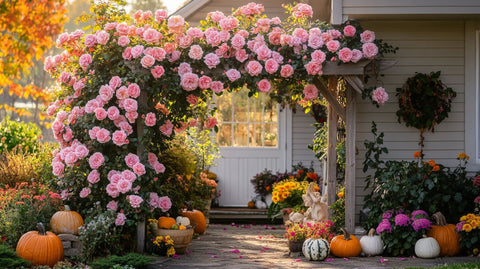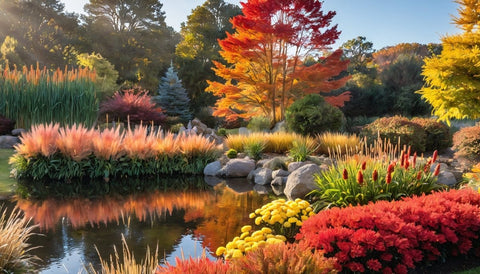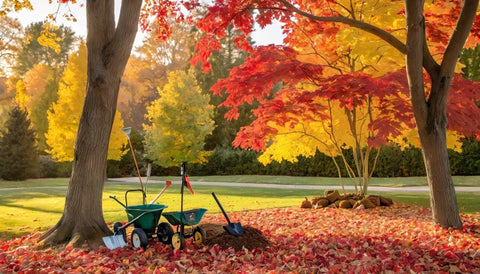Introduction
There’s something undeniably enchanting about climbing roses; their elegant petals dancing in the breeze adds a romantic vibe to any garden. And if you think spring is the only time for planting, think again! Fall gardening offers a unique opportunity to create a flourishing landscape, especially with these beauties. In this post, we’re diving into how to cultivate a stunning fall garden using climbing roses.

Understanding Climbing Roses
1.1. Types of Climbing Roses
When it comes to climbing roses, you've got options! Some popular varieties include:
- New Dawn: This soft-pink wonder blooms repeatedly and is known for its sweet fragrance.
- Don Juan: A classic red climber that brings drama with its large blooms.
- Climbing Iceberg: A white variety that’s hardy and produces clusters of flowers.
1.2. Benefits of Climbing Roses in the Garden
Climbing roses aren't just pretty faces! They add aesthetic charm, save space in smaller gardens, and are fantastic at attracting pollinators. Trust me, your garden will thank you!
Planning Your Fall Garden
2.1. Ideal Location for Climbing Roses
First things first, you need to find the right spot for your climbing roses. They love sunlight, so aim for a location that gets at least six hours a day. The soil? Well-draining is the name of the game. Plus, make sure you position them near a fence or trellis for those beautiful climbs!
2.2. Designing Your Climbing Rose Layout
Now that you've picked the perfect spot, it’s time to get creative! Garden structures like trellises, arches, and fences not only support your climbing beauties but also enhance your garden’s charisma. Add some companion plants like marigolds or herbs, and watch how they thrive together.

Preparing Your Garden Bed
3.1. Soil Preparation
Think of soil as the foundation of your garden. The more organic matter you mix in, the better! Compost, well-rotted manure, and peat moss are great options for ensuring your climbing roses have everything they need to flourish this fall.
3.2. Tools and Supplies Needed
Before you get started, gather these essential tools: a spade, garden fork, watering can, and perhaps a good pair of gloves. For soil amendments, consider using a balanced fertilizer tailored for roses to give them that extra boost!
Planting Climbing Roses
4.1. When to Plant in Fall
Timing is crucial. In most regions, late September to early November is ideal. However, check your local climate to find that sweet spot!
4.2. Step-by-Step Planting Guide
Here’s how to get those roses in the ground:
- Prepare your planting hole—about twice as wide as the root ball.
- Immerse the roots in water for at least an hour to hydrate them.
- Place the rose in the hole, ensuring that the graft union sits slightly above soil level.
- Backfill with soil, firming gently, and finish off with a good mulch layer to retain moisture.
Caring for Your Climbing Roses
5.1. Watering and Fertilizing
Keep your climbing roses hydrated, especially during dry spells. Regular watering is key, but let the soil dry out between waterings to avoid root rot. For fertilization, a balanced rose-specific mix applied in fall will keep your plants nourished for the winter ahead.
5.2. Pruning and Maintenance
Don’t shy away from a little pruning! In late fall, cut back any dead or diseased branches. This not only promotes healthy growth in spring but also encourages better air circulation.
5.3. Protecting Roses from Winter Elements
As winter approaches, mulching is your best friend. A good mulch layer will insulate roots and prevent freeze-thaw cycles. You might also want to wrap the base of the roses with burlap if winters get particularly harsh.

Adding Fall Elements to Your Garden
6.1. Complementing Climbing Roses with Autumn Decor
As your climbing roses flourish, embrace the season! Deck out your garden with pumpkins, gourds, and cheerful colors. These elements will not only bring your garden to life but also create a cozy autumn atmosphere.
6.2. Selecting Companion Plants for Fall Interest
To add flair during the fall, choose companion plants that bloom around the same time, like asters and chrysanthemums. Their vibrant foliage and flowers will complement your climbing roses beautifully!
Conclusion
Creating a fall garden with climbing roses is a rewarding endeavor that brings beauty and vibrancy to your landscape. So roll up your sleeves, embrace the process, and don’t hesitate to share your experiences or questions in the comments below. Happy gardening!






























Comments (0)
There are no comments for this article. Be the first one to leave a message!